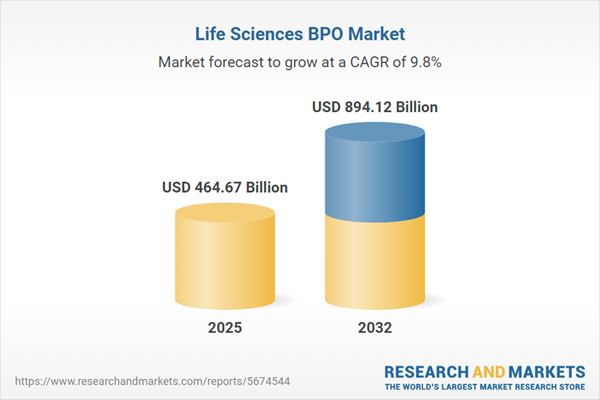Speak directly to the analyst to clarify any post sales queries you may have.
The life sciences BPO market is undergoing significant transformation as industry leaders seek streamlined solutions to manage compliance, drive operational efficiency, and address evolving regulatory dynamics. Strategic outsourcing is vital for maintaining resilience, optimizing resources, and sustaining competitive advantage in a rapidly changing environment.
Market Snapshot: Life Sciences BPO Market Size and Forecast
The global life sciences BPO market is set to expand from USD 423.92 billion in 2024 to USD 464.67 billion in 2025, with expectations to reach USD 894.12 billion by 2032—reflecting a compound annual growth rate of 9.77%.
This growth is fueled by rising demand for specialized outsourcing in regulatory, therapeutic, and operational domains. Companies increasingly embrace digital transformation to automate workflows, enhance compliance measures, and build more efficient partnerships. Leading providers integrate advanced technology and collaborative models to improve outcomes, enabling organizations to remain agile and responsive across the evolving life sciences supply chain.Scope & Segmentation of the Life Sciences BPO Market
This report equips senior executives with the insights necessary to refine outsourcing strategies within a complex international market. The following segments reflect the breadth and depth of BPO offerings and their impact on business strategy, regulatory compliance, and operational performance:
- Service Types: Broad BPO solutions covering clinical development, commercial activities, medical affairs, pharmacovigilance, and regulatory affairs, enabling organizations to enhance business efficiency and meet evolving compliance requirements.
- Clinical Development: Outsourcing support for data management, trial oversight, logistics management, and compliance assurance to promote stable project execution and reliable delivery.
- Commercial Services: Expert-driven market planning, analytics, and stakeholder engagement strategies to optimize go-to-market tactics and drive commercial success.
- Medical Affairs: Focused on scientific communication and regulatory review to elevate collaboration with healthcare professionals and regulatory bodies.
- Pharmacovigilance: Specialized monitoring and post-market surveillance to uphold patient safety and ensure adherence to safety regulations worldwide.
- Regulatory Affairs: Streamlined global submission, labeling, and compliance strategies supporting product approval and market entry in complex markets.
- End Users: Outsourcing platforms tailored for pharmaceutical manufacturers, biotechnology companies, and medical device enterprises to improve productivity, resource optimization, and strategic alignment.
- Outsourcing Models: Flexible delivery with onshore, nearshore, and offshore approaches designed to balance operational security, regulatory compliance, and cost management.
- Organization Size: Adaptive BPO strategies that serve both large enterprises and smaller firms, addressing diverse operational challenges and scalability needs.
- Regional Coverage: Analysis includes the Americas, Europe, Middle East & Africa, and Asia-Pacific, examining unique trends, growth prospects, and regulatory frameworks in each region.
- Key Companies: Comprehensive coverage of leading BPO providers such as IQVIA Holdings Inc., Syneos Health, ICON plc, PRA Health Sciences, Parexel International, LabCorp, Charles River Laboratories, PPD, WuXi AppTec, and Medpace Holdings, illustrating market expertise and service variety.
Key Takeaways for Senior Decision-Makers
- BPO models enable optimized allocation of internal resources, advancing innovation and maintaining business flexibility to adjust to regulatory and market shifts.
- Embracing automation, artificial intelligence, cloud computing, and data analytics increases process efficiency and supports robust compliance across all divisions.
- Dynamic outsourcing frameworks allow rapid operational scaling, meeting diverse compliance needs and adapting to changing regional and global market forces.
- The deployment of blockchain and emerging digital solutions enhances supply chain transparency and improves oversight of business functions.
- Collaboration with digital health partners and integrated BPO providers strengthens operational capacity, positioning organizations for proactive response to market volatility.
- Multidisciplinary teams deliver critical expertise, facilitating effective management of region-specific regulations and cross-border supply challenges.
Tariff Impact on Life Sciences BPO Operations
Recent US tariff changes have introduced new complexities for life sciences BPO operations, particularly affecting manufacturing and international logistics. To navigate this environment, companies diversify supplier bases, emphasize nearshore service models, and redesign contracts to reduce exposure to risk. Increased automation and streamlined digital workflows support cost-effectiveness, while preserving high standards for quality and regulatory compliance.
Comprehensive Methodology & Data Sources
Our market analysis utilizes peer-reviewed publications, broad industry assessments, and insights from expert interviews. These sources are validated through structured quantitative surveys and executive workshops, generating reliable intelligence on key trends and best practices within the life sciences BPO sector.
Why This Report Matters
- Supplies actionable market intelligence and strategic guidance for effective investment, supplier selection, and ongoing operational planning.
- Facilitates management of digital initiatives and regulatory complexity throughout the business process outsourcing lifecycle, enabling robust compliance systems.
- Enables benchmarking and adaptive risk management as global regulations and commercial standards continue to evolve.
Conclusion
Early adoption of flexible, technology-driven approaches positions organizations to capitalize on emerging opportunities within the life sciences BPO marketplace. Proactive outsourcing strategies and operational agility are critical for building resilience and advancing market presence.
Additional Product Information:
- Purchase of this report includes 1 year online access with quarterly updates.
- This report can be updated on request. Please contact our Customer Experience team using the Ask a Question widget on our website.
Table of Contents
3. Executive Summary
4. Market Overview
7. Cumulative Impact of Artificial Intelligence 2025
Companies Mentioned
The companies profiled in this Life Sciences BPO market report include:- IQVIA Holdings Inc.
- Syneos Health, Inc.
- ICON plc
- PRA Health Sciences, Inc.
- Parexel International Corporation
- Laboratory Corporation of America Holdings
- Charles River Laboratories International, Inc.
- PPD, Inc.
- WuXi AppTec Co., Ltd.
- Medpace Holdings, Inc.
Table Information
| Report Attribute | Details |
|---|---|
| No. of Pages | 189 |
| Published | October 2025 |
| Forecast Period | 2025 - 2032 |
| Estimated Market Value ( USD | $ 464.67 Billion |
| Forecasted Market Value ( USD | $ 894.12 Billion |
| Compound Annual Growth Rate | 9.7% |
| Regions Covered | Global |
| No. of Companies Mentioned | 11 |









